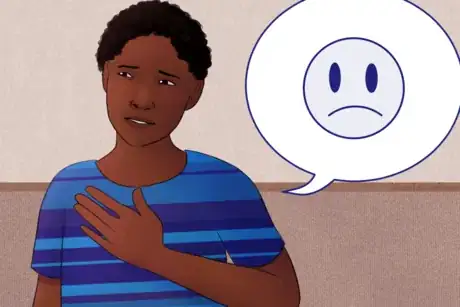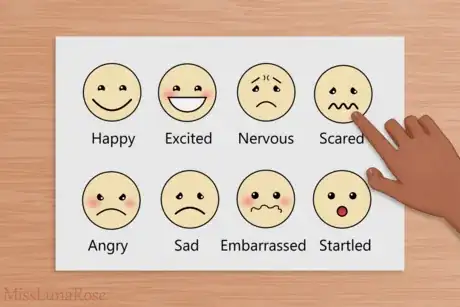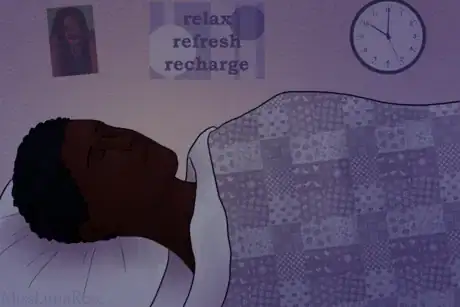This article was co-authored by Adam Dorsay, PsyD. Dr. Adam Dorsay is a licensed psychologist in private practice in San Jose, CA, and the co-creator of Project Reciprocity, an international program at Facebook's Headquarters, and a consultant with Digital Ocean’s Safety Team. He specializes in assisting high-achieving adults with relationship issues, stress reduction, anxiety, and attaining more happiness in their lives. In 2016 he gave a well-watched TEDx talk about men and emotions. Dr. Dorsay has a M.A. in Counseling from Santa Clara University and received his doctorate in Clinical Psychology in 2008.
There are 18 references cited in this article, which can be found at the bottom of the page.
wikiHow marks an article as reader-approved once it receives enough positive feedback. In this case, 100% of readers who voted found the article helpful, earning it our reader-approved status.
This article has been viewed 121,070 times.
Emotional triggers are created from past negative experiences. When placed in a position similar to that negative experience, strong emotions are stirred up, and our knee-jerk reaction can lead to emotional outbursts, panic, or "freezing up." If left unchecked, they'll continue to haunt us and control us. The good news is that there are ways that we can address these triggers and reduce our negative reactions to them.
Steps
Identifying Emotional Triggers
-
1Pay close attention to your reactions. Sometimes strong emotions come up, and you may have no idea what triggered them. However, by paying close attention over time, it’s usually possible to learn what your triggers are. This makes it easier to work with them.
- Take time to reflect after an incident involving strong emotions. Where did those feelings come from?
-
2Use a journal to identify your triggers. Write down what you felt, your reaction, where you were when the trigger took place, who you were with, and what you were doing at the time. Journaling like this is a great tool for keeping track of your triggers. Review your list and identify those emotions that evoked strong and intense reactions, otherwise known as the "fight or flight" reaction from feeling threatened in some way.Advertisement
-
3Recognize what emotions are for and how they work. Emotions help us communicate to others. They prepare us and motivate us for action, and they can be self-justifying. Sometimes emotions arise in relation to an outside event, but they also happen in relation to internal events, like thoughts and even other emotions.[1] Following are six of the major emotions:
-
4Familiarize yourself with your emotions. Your body reacts to your emotions. For instance, your heart beats faster when you feel scared. When you're angry, your body tenses or feels hot. By recognizing the cues given by your body, you'll be able to identify the emotions you're feeling. You'll then be able to address those emotions and control them before they control you.[8]
Avoiding or Changing the Triggers
-
1Change your lifestyle. Old habits are hard to break, and emotional triggers can fall into that category. To avoid and change a trigger, you'll need to replace some old habits and activities with new ones. You'll also need to avoid those circumstances that have proven to be triggers.
- For instance, if you know someone who gets belligerent when drunk and pushes a multitude of your triggers, stay away from that person when they're consuming alcohol.
- If not having enough money to pay your bills creates a trigger, then look at what you can cut from your budget.
- Avoid alcohol and other drug use. When you're under the influence of either substance and encounter a trigger, you won't have as much control over your emotions and your outbursts.
-
2Take a time-out. Sometimes a time-out can help you calm down before re-engaging with a situation. You can use this time to think about the emotions you're experiencing and how to address them effectively.
- Try saying "I need some air" or "I'll get back to you on that." If someone tries to follow you, say "I really need to be alone right now."
- For example, if you are angry with your coworker and you don't want to harm your working relationship, you could say "we'll discuss this later" and walk away. You can write a note saying that you don't want to be disturbed, put it on your office door, and go inside. Then you can take the time to figure out whether and how to respond to her.[9]
-
3Expand your window of tolerance gradually. Staying away from things that trigger you works in the short run, but it might not work in the long run. Avoiding triggers all the time can be stressful, and it may limit your life. Start small, and work your way up. Continue until you have successfully managed your emotions to the point that the experience is no longer a trigger.
- Take baby steps towards your goal. For example, perhaps you are afraid of crowds. Your first step might to briefly spend time in a crowded cafe or mall, and then leave and do something that calms you.
- Don't try to jump in headfirst. For example, if you are afraid of cats, don't lock yourself in a room with a cat right away. Perhaps step 1 is watching someone else pet a cat, or watching cat videos and learning more about cat body language so that they seem less unpredictable to you.
-
4Be patient with yourself. Habit and lifestyle changes don't typically have immediate results. It may take weeks or months before you start noticing a change. This is normal, and it doesn't mean you're doing anything wrong.[10]
- Set small goals. For example, if you tend to freeze up around a verbally abusive mother, step one might be learning how to say "I'll get back to you" and leaving the room. Don't punish yourself for not being able to ignore her yet. You have to master step 1 before you can handle step 5 or step 10.
- Reward yourself for making progress. Even if it's small progress, tell yourself that you did a great job, and be proud of yourself. Give yourself a physical reward (like a movie night or extra time to work on a hobby) if you'd like. Making progress is a big deal, so be proud of yourself!
-
1Develop different ways you can handle a trigger. Determine your desired outcomes from your triggers and what you'll need to do to accomplish them. If you can't pay a certain bill, call the creditor and work out a payment plan. If your trigger comes from being overwhelmed because you don't have time to cook dinner before attending the PTA meeting, then order take-out food.
-
2Pause to label your emotion. When you find yourself experiencing a strong emotion, stop and ask yourself "What am I feeling?" Finding a name for the feeling can help you manage it more easily.
- Try stopping to consider how your emotion is impacting your body. For example, "I'm scared. My heart is beating fast, my hands are clenched, and my legs feel ready to run away."
-
3Practice opposite actions for negative emotions. When we experience negative emotions, we can have the tendency to enforce it with negative responses. If you isolate yourself when you feel sad and lonely, you'll create more sadness and loneliness. To change the sad and lonely feelings, approach friends and safe social situations. Try to engage in activities that invoke opposite feelings.[11]
-
4Create positive experiences that lead to positive memories. Not all triggers are negative. Pleasant experiences can trigger some happy memories. Spend time with people you love, and make good memories.
- The smell of cookies might remind you of holidays at Grandma's.
- A favorite love song might bring back memories of a treasured first date.
- A beach might bring back reminders of a fun beach trip with friends.
-
5Use emotion regulation skills or distress tolerance to tolerate unpleasant feelings. You can then act out those unpleasant feelings in a way that doesn't make things worse. In fact, they can be healthy for you. Some ways you can do this include:
- Distracting yourself to help tolerate difficult feelings.
- Engaging in activities/hobbies, like knitting, drawing, or going to the movies.
- Contributing your time. Volunteer, help someone, or do something nice.
- Creating opposite emotions. Do something that creates emotions other than the one you’re experiencing, like watching a funny movie or reading a funny book.
- Pushing away and leaving the situation or blocking it in your mind.
- Using thoughts to distract, such as reading, planning something nice, or counting to ten.
- Using sensations, such as holding ice, getting a massage, or taking a hot shower.
- Managing anger by ripping up paper from the recycling bin or smashing ice cubes in the bathtub.
- Practicing self-soothing. Soothe each of the five senses with pleasant and comforting sensations.[12]
-
6Improve the moment. Find other ways to make your present distress tolerable. Practice with imagery, finding meaning, prayer, relaxation, and focusing entirely on one thing in the moment, or taking a brief vacation. Give yourself encouragement. You're stronger than you realize. After all, you're taking steps to change.
Managing Your Emotions
-
1Change your belief systems. Look at the situation through different eyes. Don't perceive it as an obstacle, but think of it as an opportunity to improve. For instance, if you're unhappy with your job, remind yourself that you have the power to change what you don't like. Look at your current job as a training ground and a way to build your resume so that when you do look for another job, you'll be more marketable.
-
2Learn to set boundaries. Sometimes our emotional triggers are the result of not setting boundaries and letting others know what they are. Boundaries tell people what you will and won't allow. They also set limits on what you will and won't do.[13]
-
3Reduce vulnerability to stress. Our bodies are like machines. If we drove our cars without gas or changing the oil, we'd eventually break down. When we neglect our bodies, not only can we break down, but doing so can affect us emotionally and not in a good way. Therefore, we must take care of ourselves. We need to:
- Treat physical illness. If you’re sick, you may feel sad, angry, or frustrated. Seek medical attention and rest to recover from your illness.
- Eat well. Eat when you're hungry, and stop when you're full. Try to integrate fruits and vegetables into your daily diet. Avoid restrictive diets, yo-yo dieting, and diets that cut out certain food groups (as these tend not to be sustainable). A balanced diet contributes to balanced moods. Eating well can help you feel better.[14]
- Get enough sleep. Keep a regular sleep schedule, and make sure you get enough sleep each night.[15]
- Exercise. Twenty minutes of vigorous exercise each day can help balance moods.[16]
-
4Enjoy good experiences. When you experience positive feelings, make sure you take time to slow down and notice the pleasant experiences. Soak in the goodness, joy, and comfort.[17] Do (at least) one thing each day that makes you feel good. You'll build your resilience while increasing your ability to experience more good moods.
- Laugh.
- Take a walk in the park.
- Ride your bike.
- Read a book.[18]
- Spend time with someone who makes you smile.
-
5Build a life worth living by making small changes each day. You'll experience more positive events over the long term. Work toward a dream project, a career change, or self-improvement by taking small steps each day. Do something that helps you feel competent and in control. This helps regulate your emotions and gives positive feedback for your sense of purpose.[19]
Getting Help
-
1Talk to your family members and friends about the triggering situation and your feelings. Sometimes talking can really help reduce emotional triggers and promote understanding. Your family and friends know you better than anyone. They know when to anticipate your triggers, so they can help encourage you during those times.[20]
- Ask them to soothe and comfort you. A little care can go a long way in reducing triggered emotions.
- If your triggered emotions have to do with feeling unsafe, your friends or family could help you. For example, if you feel too afraid to go outside alone, they could go with you to the store or to the park.
-
2Tell people how they can help you when they see you feeling upset. Quit lying and saying "I'm fine." Instead, be honest about what you need.
- "I need to be alone right now so I can sort out my feelings. We can talk later."
- "I could use a hug."
- "I'm feeling sad. You can't fix it, but I could really use a friend to help me take my mind off of things. Could we do something fun?"
- "I'm upset about your teasing. My voice is kind of a sore spot for me... would you mind not teasing me about it anymore?"
- "I just need a few minutes to calm down."
- "I'm having trouble sorting out a problem at work. Do you have time to listen?"
-
3Get professional help. Find a good counselor, social worker, or psychotherapist. Lots of people have trouble managing their emotions and dealing with triggers. People with special training can help you identify your triggers, and they can teach you strategies for dealing with them.
-
4Speak to a spiritual director, pastor, or doctor. These are caring professionals who may have tools for helping people work with intense emotions, or they can refer you to someone who does. A spiritual director or pastor can also give you spiritual guidance that can help you during those times when you're trying to manage your emotions. A doctor can prescribe medication if needed that can alleviate emotions like stress and depression.
-
5Seek out well-written self-help books on emotions and triggers. Anger management and emotion regulation might be good places to start. Books dealing with trauma could help you identify the root of your triggers. If you've already identified the reasons behind your triggers, then read books about that topic. For instance, if your triggers are caused from being in an abusive relationship, then look for books about domestic violence and abuse.
-
6Consider attending a support group. Often groups can help work with and understand emotions. Some of the members within a group have confronted the same triggers and therefore can provide some helpful suggestions. Search the Internet or ask a counselor or therapist to help you find support groups in your area.
Expert Q&A
-
QuestionHow to stop a triggering event triggered by others triggering?
 Shari Forschen, NP, MAShari Forschen is a Registered Nurse at Sanford Health in North Dakota. Shari has worked in healthcare since 1996 and her expertise lies in acute care bedside nursing on a medical oncology floor. She received her degree from Medcenter one College of Nursing in 2003 and her Family Nurse Practitioner Masters from the University of North Dakota in 2014. Shari is a member of the American Nurses Association.
Shari Forschen, NP, MAShari Forschen is a Registered Nurse at Sanford Health in North Dakota. Shari has worked in healthcare since 1996 and her expertise lies in acute care bedside nursing on a medical oncology floor. She received her degree from Medcenter one College of Nursing in 2003 and her Family Nurse Practitioner Masters from the University of North Dakota in 2014. Shari is a member of the American Nurses Association.
Master's Degree, Nursing, University of North Dakota Triggers often resolved unresolved feelings or emotions toward an event. Best advice would be to go to a therapist who practices cognitive behavioral therapy and do the work so you can move beyond this specific issue. It may take time and effort, but is worth it.
Triggers often resolved unresolved feelings or emotions toward an event. Best advice would be to go to a therapist who practices cognitive behavioral therapy and do the work so you can move beyond this specific issue. It may take time and effort, but is worth it.
References
- ↑ http://www.dbtselfhelp.com/html/er_handout_3.html
- ↑ http://www.theguardian.com/commentisfree/2012/dec/13/what-is-love-five-theories
- ↑ http://www.pbs.org/thisemotionallife/topic/happiness/what-happiness
- ↑ http://www.pbs.org/thisemotionallife/topic/anger/what-anger
- ↑ http://www.eruptingmind.com/how-to-deal-with-sadness/
- ↑ http://www.emotionalcompetency.com/fear.htm
- ↑ http://blogs.psychcentral.com/emotionally-sensitive/2012/06/understanding-shame/
- ↑ http://www.dbtselfhelp.com/html/describing1.html
- ↑ http://www.mayoclinic.org/healthy-lifestyle/adult-health/in-depth/anger-management/art-20045434
- ↑ Adam Dorsay, PsyD. Licensed Psychologist. Expert Interview. 14 May 2019.
- ↑ http://www.mindfulnessmuse.com/dialectical-behavior-therapy/10-practical-examples-of-opposite-action-part-one
- ↑ http://www.dbtselfhelp.com/html/self-sooth.html
- ↑ Adam Dorsay, PsyD. Licensed Psychologist. Expert Interview. 14 May 2019.
- ↑ http://www.sciencedirect.com/science/article/pii/S1057740814000060
- ↑ http://www.webmd.com/sleep-disorders/excessive-sleepiness-10/emotions-cognitive
- ↑ http://www.apa.org/monitor/2011/12/exercise.aspx
- ↑ http://dbtselfhelp.com/html/positives.html
- ↑ http://www.dbtselfhelp.com/html/er_handout_8.html
- ↑ http://www.dbtselfhelp.com/html/reduce_vulnerability.html
- ↑ Adam Dorsay, PsyD. Licensed Psychologist. Expert Interview. 14 May 2019.
About This Article
If you’re having trouble managing your emotional triggers, it may help to start paying closer attention your reactions in order to make triggers easier to identify. Try keeping a journal to track the times you’re triggered, and include what you felt, your location at the time, and who you were with. Next, familiarize yourself with your emotions and how your body reacts to them. If you notice your heart beats faster or you feel hot, follow the cues and take a moment to cool down before emotions overcome you. For our Medical reviewer’s tips on how to break habits that trigger your emotions, scroll down!






























-Step-13.webp)
























































